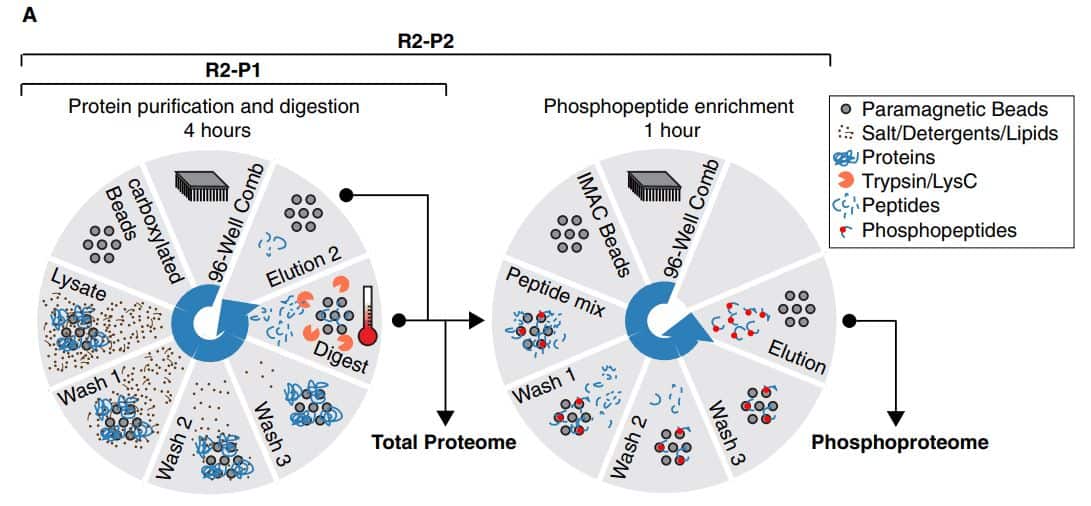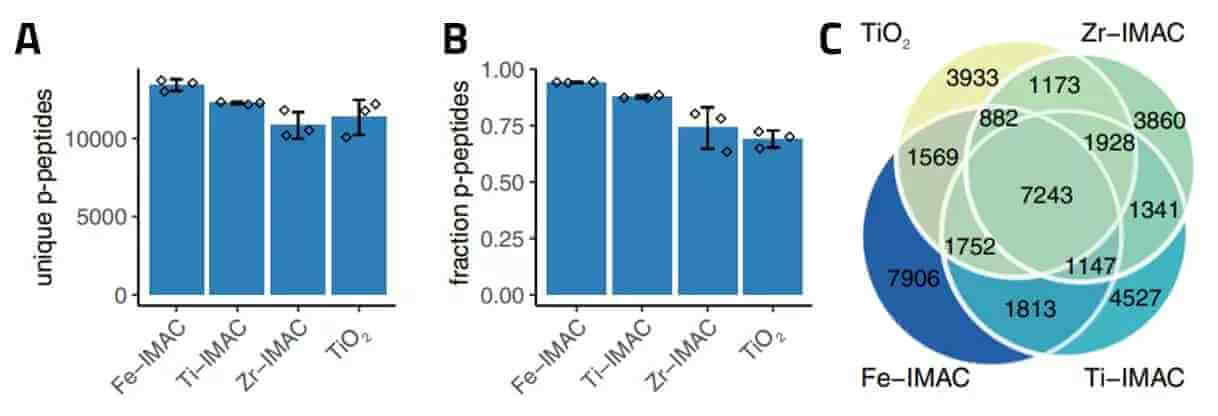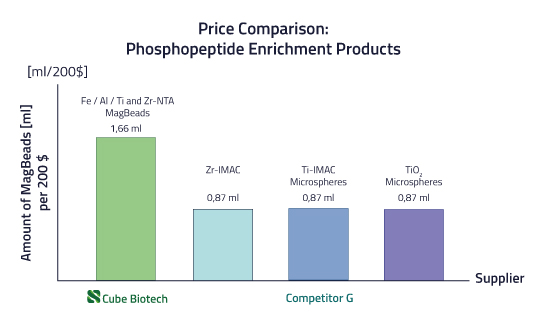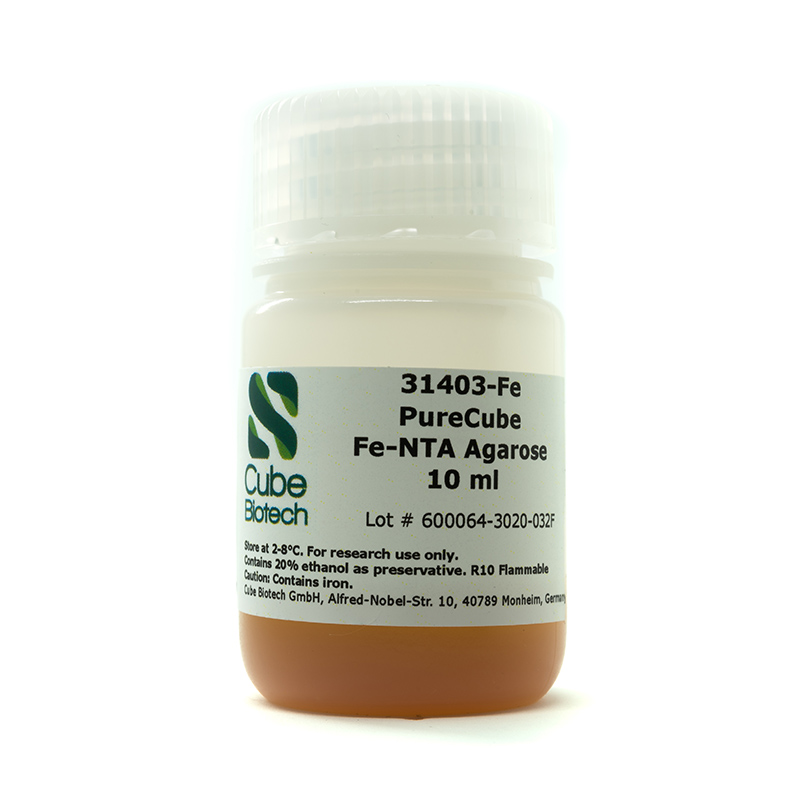PureCube Fe-NTA Agarose
Order number: 31410-Fe
Description
PureCube Fe-NTA agarose resin beads were developed for the enrichment of phosphorylated proteins. They can also be used for the purification of his tagged proteins as a secondary function. The affinity matrix is based on 7.5% cross-linked agarose that was magnetized. The bead ligand is Fe-NTA and the particle diameter is 40 µm. They are very homogeneous in size, yielding in a high degree of reproducibility.
As an alternative we also offer PureCube Fe-NTA MagBeads and this resin pre-packed in cartridges/columns.
As an alternative we also offer PureCube Fe-NTA MagBeads and this resin pre-packed in cartridges/columns.
Datasheets
- Fe-NTA Agarose Datasheet
- Phosphopeptide Enrichment Protocol
This protocol is written for the use of magnetic beads use it as a reference to create a corresponding agarose resin protocol.
| Feature | |
|---|---|
| Usage |
|
| Specificity |
|
| Bead ligand | Fe-NTA |
| Bead size | 40 µm |
| Filling quantity | Delivered as a 50 % suspension |
| Matrix | 7.5% crosslinked agarose |
| Chelator stability | Stable in buffer containing 10 mM DTT and 1 mM EDTA |
| pH stability | 2-14 |
| Other stabilities | 100% methanol, 100% ethanol, 8 M urea, 6 M guanidinium hydrochloride, 30% (v/v) acetonitrile |
Citations
Lab Results
Automatic Phosphoproteomics for high-throughput projects
Fe-NTA magnetic beads by Cube Biotech have been proven to increase the speed of a high throughput experiment drastically. Leutert et al. (2019) presented the application of PureCube Fe-NTA MagBeads in a procedure that they named R2-P2, which is short for Rapid-Robotic PhosphoProteomics. They used a KingFisherTM Flex for their robotic runs to fully automize the phosphopeptide enrichment process.
Fe-NTA magnetic beads by Cube Biotech have been proven to increase the speed of a high throughput experiment drastically. Leutert et al. (2019) presented the application of PureCube Fe-NTA MagBeads in a procedure that they named R2-P2, which is short for Rapid-Robotic PhosphoProteomics. They used a KingFisherTM Flex for their robotic runs to fully automize the phosphopeptide enrichment process.

Source: Leutert et al. (2019)
Superiority over other phosphopeptide enrichment methods
Leutert et al. compared three different types of IMAC beads (including our PureCube Fe-NTA) and TiO2 microspheres. As it can be seen in figure 2 our PureCube Fe-NTA magnetic beads presented themselves to be the best option for phosphopeptide enrichment. With our Fe-NTA MagBeads the most unique phosphopeptides (Fig. 2 A and C) were enriched with the highest efficiency (Figure 2 B).
Leutert et al. compared three different types of IMAC beads (including our PureCube Fe-NTA) and TiO2 microspheres. As it can be seen in figure 2 our PureCube Fe-NTA magnetic beads presented themselves to be the best option for phosphopeptide enrichment. With our Fe-NTA MagBeads the most unique phosphopeptides (Fig. 2 A and C) were enriched with the highest efficiency (Figure 2 B).

Source: Leutert et al. (2019)
The best product for the best prize
Analyzing and comparing products from various manufacturers and suppliers can often prove to be a laborious task. The presence of varying concentrations and volumes across different suppliers can lead to confusion when trying to identify the optimal cost-benefit ratio. Recognizing these challenges, Cube Biotech has undertaken the effort to compile a comprehensive overview of prices for the frequently utilized phosphopeptide enrichment products (Fig. 2 C). Our intention is to provide researchers with a clearer understanding of the prevailing pricing landscape in the market, facilitating informed decision-making.
Analyzing and comparing products from various manufacturers and suppliers can often prove to be a laborious task. The presence of varying concentrations and volumes across different suppliers can lead to confusion when trying to identify the optimal cost-benefit ratio. Recognizing these challenges, Cube Biotech has undertaken the effort to compile a comprehensive overview of prices for the frequently utilized phosphopeptide enrichment products (Fig. 2 C). Our intention is to provide researchers with a clearer understanding of the prevailing pricing landscape in the market, facilitating informed decision-making.

FAQ
Can I get the datasheet for the Fe-NTA MagBeads?
What can I do with Fe-NTA beads?
Fe-NTA beads serve two purposes. First, they can be used as the matrix to bind and thus enrich phophopeptides. Second, they can be used similar to e.g Ni-NTA to purify His-tagged proteins via IMAC.
How does the phosphopeptide enrichment process work?
Use this protocol as a reference. It is written for our PureCube Fe-NTA MagBeads, so you have to make some adjustments to it.
Can I enrich all phosphopeptides using Fe-NTA?
No, this is not possible. Not all phosphopeptides bind to Fe-NTA beads. As shown in figure 2 multiples bead types must be used to cover all phosphopeptides off a cell. Because of that we also offer Ti- Zr- and Al-NTA beads.



